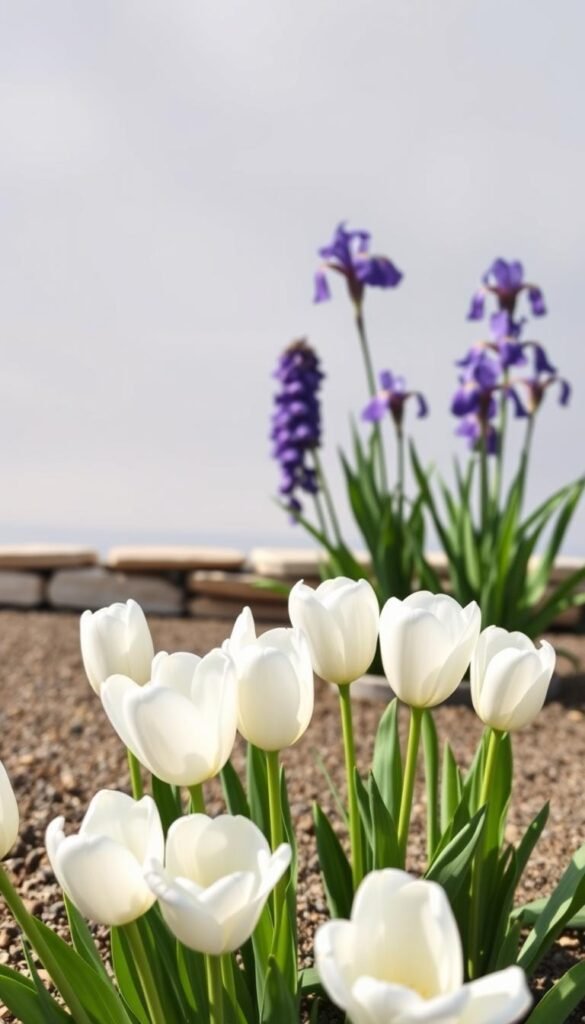Imagine transforming your outdoor space into a breathtaking display of color and texture without overwhelming complexity. This approach focuses on strategic plant selection and bold groupings that command attention. Inspired by landscape pioneers Wolfgang Oehme and James van Sweden, modern gardeners are embracing the power of repetition to craft unforgettable spaces.
The secret lies in mass planting – arranging large clusters of the same variety rather than scattering single specimens. Picture 3,000 black-eyed Susans swaying together instead of six lonely stems. This technique creates living tapestries that thrive through natural cooperation, reducing maintenance while amplifying visual drama.
You’ll discover how this method works equally well for urban balconies as for sprawling properties. By concentrating your efforts on fewer plant types, you create stronger focal points and healthier growing conditions. The result? A space that feels intentional, harmonious, and effortlessly striking.
Throughout this guide, you’ll learn to harness nature’s patterns through intentional design. We’ll explore how repetition creates rhythm, why grouped plants often outperform solitary ones, and how to achieve year-round interest with smart variety choices. Get ready to rethink what’s possible in your own garden – less truly becomes more when every plant serves a purpose.
Embracing the Minimalist Garden Design
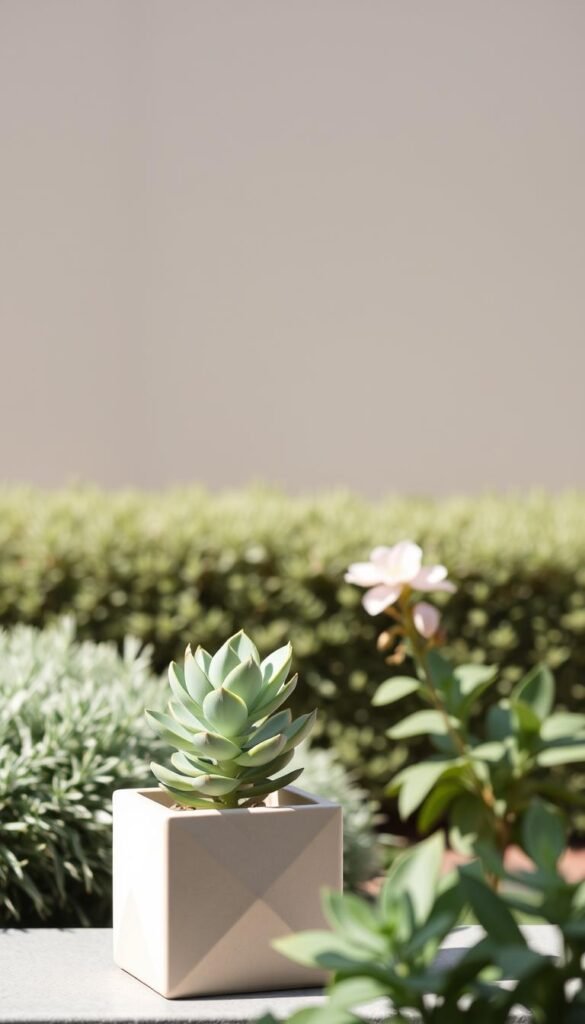
Nature teaches us that simplicity breeds beauty—observe wild meadows where plants thrive in unified clusters. This approach mirrors natural ecosystems while offering structured elegance for modern spaces. Let’s explore how intentional restraint can elevate your outdoor areas.
Defining Minimalism in Gardening
Minimalist garden design focuses on purposeful plant selection rather than quantity. It’s about creating rhythm through repetition, like prairie grasses waving in synchronized patterns. By grouping identical plants, you mimic nature’s efficiency while reducing upkeep.
Benefits of a Less-Is-More Approach
This strategy cuts maintenance by up to 40% compared to traditional gardens. Identical plant groups share water needs and resist pests collectively. You’ll spend less time weeding and more enjoying your serene oasis.
| Aspect | Traditional Gardens | Minimalist Gardens |
|---|---|---|
| Weekly Care | 5-7 hours | 2-3 hours |
| Plant Varieties | 25+ species | 3-5 species |
| Visual Impact | Scattered focus | Bold statements |
Grouped plantings create living mosaics that evolve with seasons. They attract pollinators more effectively and establish microclimates that boost growth. Your space becomes a sanctuary where every element serves both ecological and aesthetic roles.
Understanding Mass Planting Techniques
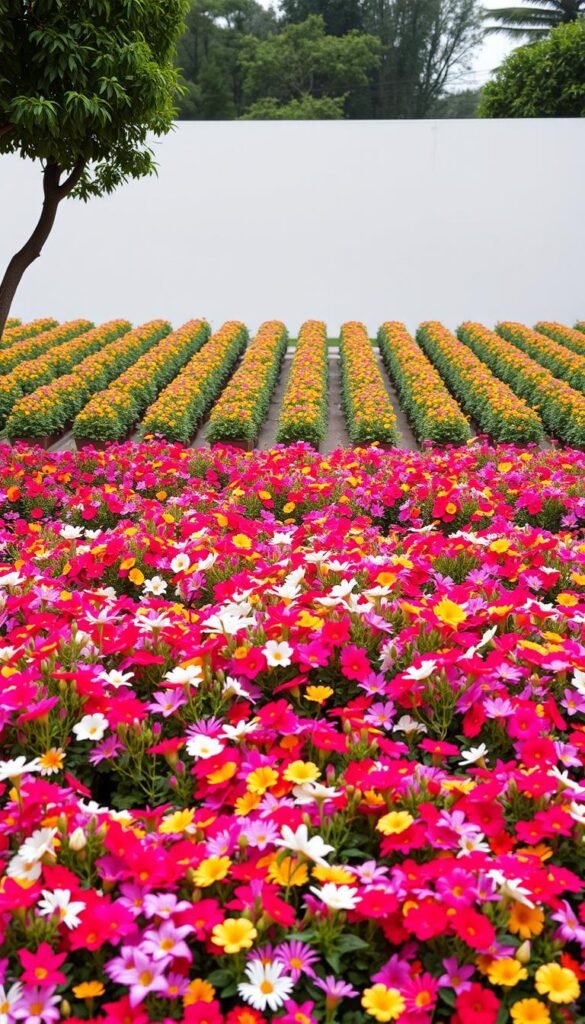
Master the art of impactful gardening through strategic plant grouping. Landscape professionals like Wolfgang Oehme champion this method, where repetition becomes your greatest design tool. Start with seven identical specimens – the magic number for creating visual weight.
Insights from Expert Landscape Designers
Renowned designer Craig Wakefield shares:
“Seven plants form the foundation. From there, scale up or down based on your space – even clustered containers create rhythm.”
This approach works across plant types:
| Plant Type | Formal Style | Informal Style |
|---|---|---|
| Ornamental Grasses | Geometric rows | Wavy drifts |
| Flowering Perennials | Symmetrical blocks | Naturalized clusters |
| Woody Shrubs | Trimmed hedges | Organic groupings |
Step-by-Step Guide to Planting En Masse
1. Choose your champions: Pick 2-3 varieties that thrive in your conditions. Sturdy options like coneflowers or feather reed grass work well.
2. Prep your canvas: Amend soil with compost for healthy roots. Space plants using their mature width as your guide.
3. Create repetition: Arrange in odd-numbered groups (7, 15, 21) for natural appeal. On patios, cluster 5-6 matching pots.
Whether planting 50 Evolution™ coneflowers or seven Nitty Gritty™ roses, this technique transforms any space. You’ll create living architecture that demands attention while simplifying care.
Choosing the Right Location and Garden Layout
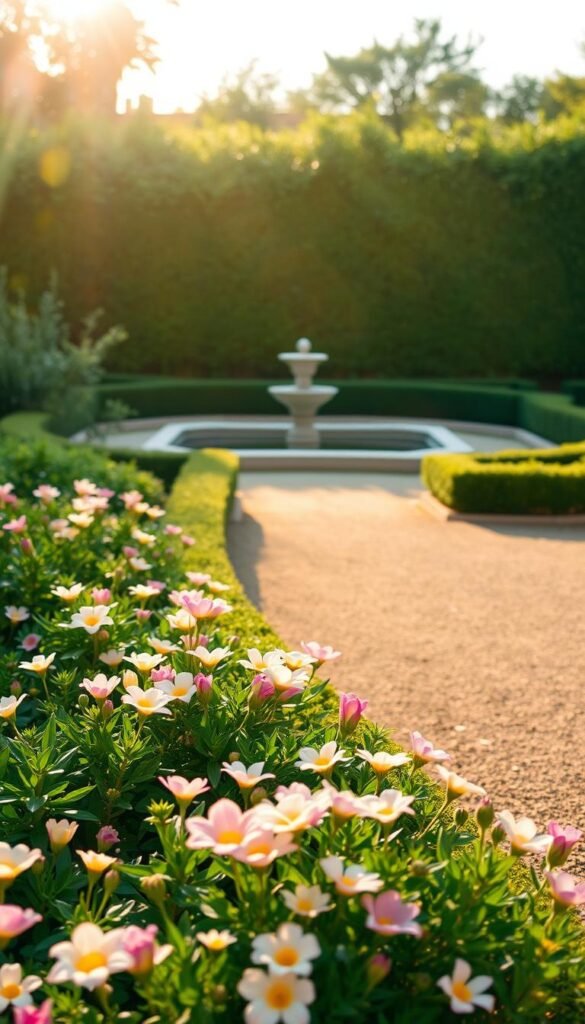
Your garden’s success begins with understanding sunlight and soil dynamics. Spend three days tracking how light moves across your space before breaking ground. Morning sun differs from afternoon intensity – this awareness helps match plants to their ideal conditions.
Maximizing Sunlight and Accessibility
Full sun means six+ hours of direct light – crucial for blooms. Use this simple test: place stones where shadows fall at 9 AM, noon, and 3 PM. The sunniest spots become prime real estate for plants like coneflowers or daylilies.
| Location Factor | Ideal Conditions | Quick Fixes |
|---|---|---|
| Sun Exposure | 6-8 hours direct light | Trim overhanging branches |
| Soil Drainage | 1″ water absorption/hour | Add compost or sand |
| Access Path | 3-foot wide walkways | Use stepping stones |
Test soil drainage by digging a 12″ hole and filling it with water. If it drains in less than 4 hours, you’re golden. For heavy clay, mix in peat moss – your plants will thank you with deeper roots.
Position your garden near patios or windows for effortless enjoyment. This strategic placement turns maintenance into mindfulness moments. Remember, even small spaces shine through colorful container gardening techniques.
Groupings thrive when soil conditions stay consistent. Avoid placing mass plantings near competing tree roots or runoff areas. Your chosen area becomes a living stage where nature’s patterns unfold daily.
Creating a Minimalist Flower Garden: Fewer Varieties, Maximum Impact
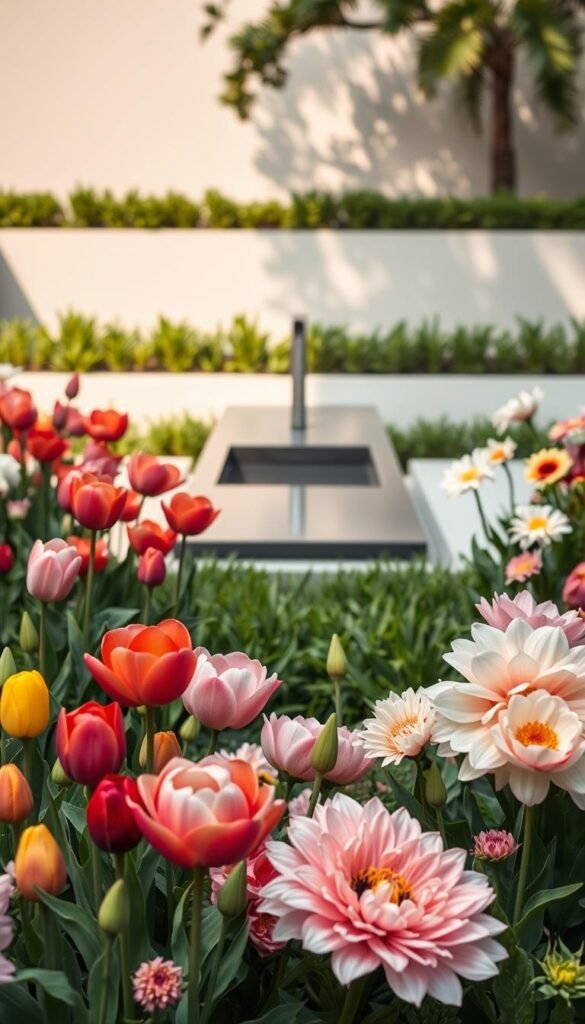
Craig Wakefield’s Philadelphia masterpiece proves bold simplicity works anywhere. His design pairs feathery astilbe plumes with low sedge grass, creating soft movement that enchants small yards and large estates alike. The secret? Letting one star plant dominate while supporting players add texture.
Notice how a solitary butterfly bush anchors the composition. This strategic specimen breaks repetition without stealing focus. It’s like punctuation in a visual sentence – guiding eyes through the space while maintaining harmony.
| Design Element | Traditional Approach | Minimalist Method |
|---|---|---|
| Color Distribution | Mixed rainbow hues | Monochrome waves |
| Plant Count | 12+ varieties | 3 key players |
| Focal Points | Multiple competing features | Single anchor plant |
Massed flowers create living rivers of color. Seven astilbe clusters mimic natural meadows better than scattered mixes. You’ll notice pollinators linger longer when they find abundant same-species blooms.
This approach simplifies care while amplifying beauty. Identical plants share water needs and crowd out weeds naturally. Your space becomes a curated gallery where each variety shines without competition.
Selecting Suitable Plants and Perennials
The right plant choices form the backbone of your garden’s success. Long-living perennials like peonies establish themselves over years, requiring less work while delivering bigger blooms. These reliable performers pair beautifully with annuals that fill seasonal gaps with bursts of color.
Balancing Annuals and Perennials for Continuous Bloom
Daylilies and lavender create permanent structure, while marigolds or zinnias add temporary vibrancy. Perennials save you money long-term – some varieties live 20+ years! Use annuals strategically in containers or between established clusters for pops of seasonal interest.
Working with Hardiness Zones and Soil Types
Check your USDA zone before choosing plants. A quick soil test reveals pH levels and texture – most perennials thrive in well-draining earth. Match selections to your conditions instead of fighting nature.
| Plant | Zones | Soil Preference |
|---|---|---|
| Russian Sage | 4-9 | Sandy/loamy |
| Black-Eyed Susan | 3-9 | Average fertility |
| Sedum | 3-11 | Rocky/dry |
Group plants with similar needs to simplify care. This approach creates self-sustaining ecosystems where roots work together. You’ll spend less time adjusting water levels and more enjoying your thriving space.
Design Inspirations and Garden Styles
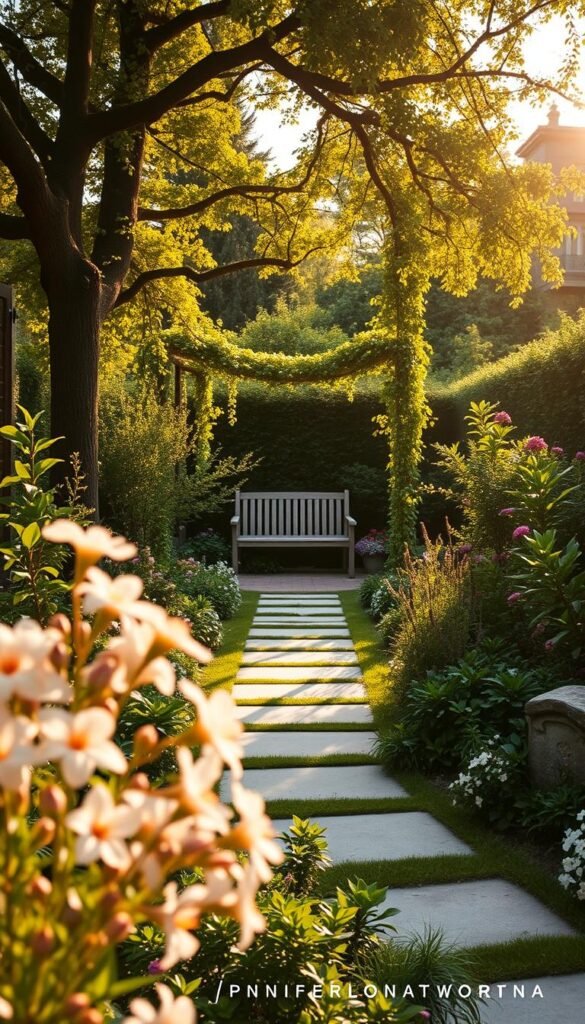
Your outdoor space becomes a canvas where design philosophies collide—will you paint with crisp geometry or wild brushstrokes? Contemporary approaches blend clean lines with nature’s spontaneity, offering fresh ways to shape your landscape. Let’s explore how different visions translate into living art.
Architectural Precision Meets Rustic Charm
Modern minimalist gardens thrive on repetition—think identical ornamental grasses marching in precise formation. Cottage styles, by contrast, celebrate controlled chaos with layered blooms. Both approaches benefit from mass planting, but their execution differs dramatically.
| Style Element | Modern Minimalism | Cottage Influence |
|---|---|---|
| Plant Selection | 3-5 species in blocks | 7+ varieties in drifts |
| Color Strategy | Monochromatic themes | Mixed complementary hues |
| Structural Features | Geometric hardscaping | Weathered stone paths |
Landscape architect Lauren Dunec Hoang notes:
“Massed plantings adapt beautifully across styles—use regimented rows for modern spaces and meandering clusters for cottage charm.”
You’ll discover how to merge these worlds. Try grouping seven hydrangeas in symmetrical beds, then underplant with loose lavender waves. This hybrid approach maintains order while nodding to rustic traditions.
Your garden’s look should mirror what makes your heart sing. Prefer structured serenity? Opt for monochromatic grasses in strict grids. Crave whimsy? Massed zinnias in rainbow clusters create joyful spontaneity. Either way, plants become your paintbrush—how will you compose your masterpiece?
Implementing Mass Planting for Visual Impact
Transform your outdoor space into a living tapestry through strategic plant grouping. Landscape architect Rob Steiner’s Pacific Palisades project demonstrates how ornamental grasses create flowing movement. Their arching stems soften concrete edges while adding prairie-inspired texture.
Techniques for a Cohesive Drifting Effect
Space plants at 75% of their mature width. This allows natural spreading while maintaining definition. For grasses like switchgrass or feather reed, plant in odd-numbered clusters of 9-15. They’ll merge into billowing waves within two growing seasons.
Maintenance Tips for Massed Plantings
Apply 3″ of mulch annually to suppress weeds and retain moisture. Enrich soil each spring with compost – this feeds roots without excessive fertilization. Pair these practices with sustainable planting methods for lasting results.
Resist overcrowding! Three properly spaced clumps create more impact than six cramped ones. Your garden gains depth as plants intermingle naturally, proving restraint often delivers the most dramatic look.

